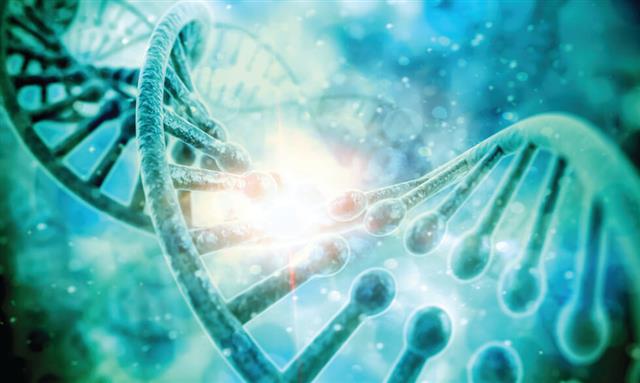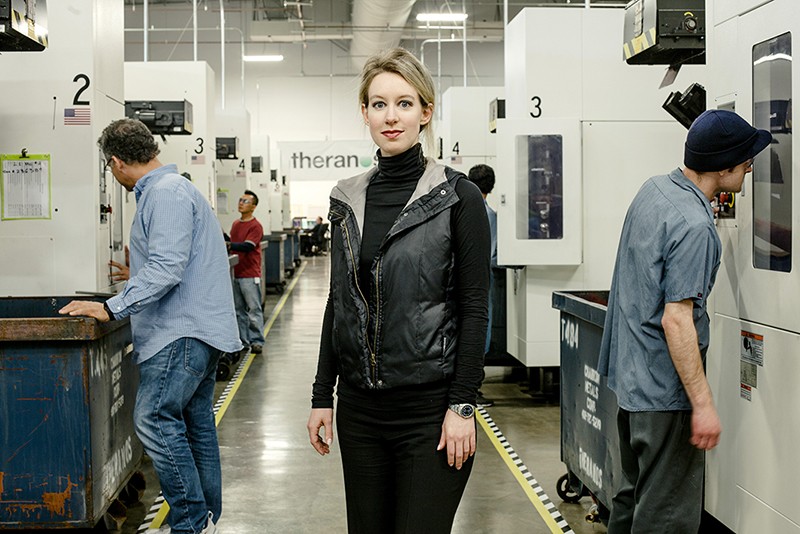(원문)
Eric Topol extols a gripping account of the rise and fall of the US medical-testing company.
Elizabeth Holmes, chief executive of Theranos, in a company facility in Newark, California.Credit: Carlos Chavarria/NYT/Redux/eyevine
Bad Blood: Secrets and Lies in a Silicon Valley Startup John Carreyrou Knopf (2018)
Few scandals have so gripped both the health-care and technology industries as the seismic rise and fall of blood-testing company Theranos. In Bad Blood, acclaimed investigative journalist John Carreyrou, who broke the story in 2015, presents comprehensive evidence of the fraud perpetrated by Theranos chief executive Elizabeth Holmes. Specifically, Holmes and the company’s former president Ramesh ‘Sunny’ Balwani raised more than US$700 million through “elaborate, years-long fraud in which they exaggerated or made false statements about the company’s technology, business, and financial performance”, as the US Securities and Exchange Commission put it in March this year.
By the time Carreyrou’s Wall Street Journal story and a long chain of follow-ups had led to regulators closing down Theranos’s labs in 2016, nearly 1 million lab tests had been run in California and Arizona. A significant proportion of these were erroneous; all had to be voided. An untold number of people were harmed by the erroneous results: some underwent unnecessary procedures, received misdiagnoses of serious conditions and experienced emotional turmoil.
Carreyrou presents the scientific, human, legal and social sides of the story in full. Although some of it was previously reported in his extensive coverage, he unveils many dark secrets of Theranos that have not previously been laid bare.
The company’s alluring goal, which changed as it evolved, was to quickly analyse a drop of blood for hundreds of different assays, at a fraction of prevailing costs. Collected in ‘nanotainers’ and allegedly tested in a diagnostic ‘miniLab’ the size of a microwave oven, the method was publicized as revolutionizing an industry that hadn’t changed for decades. Holmes, who idolized Apple entrepreneur Steve Jobs, called it “the iPod of health care”.
As a child in the 1990s in the United States, Holmes declared that she wanted to be a billionaire when she grew up. By age 30, she had achieved her goal. Highly intelligent, she had been accepted in 2002 to study chemical engineering at Stanford University in California as a President’s Scholar, a prestigious programme that comes with a grant. She dropped out in her second year to start Real-Time Cures, the Palo Alto-based company that became Theranos and operated for 15 years.
Carreyrou explores Holmes’s talents and liabilities. Driven, and with an exceptional gift for selling ideas, she built up a board of high-level political figures, such as former secretaries of state George Shultz and Henry Kissinger, former secretary of defence William Perry, Marine Corps general (now secretary of defence) James ‘Mad Dog’ Mattis, and former senator Sam Nunn. Investors included media magnate Rupert Murdoch; partners numbered supermarket giant Safeway and pharmacy chain Walgreens. Channing Robertson, a professor of Holmes’s at Stanford, was a board member and adviser to the company. In 2015, Holmes was recognized by then-president Barack Obama as a US ambassador for global entrepreneurship. The same year, vice-president Joe Biden sang her praises at a launch of the miniLab (which Carreyrou uncovers as completely fake; the lab was not operational at the time).
All the while, as Carreyrou reports, Holmes was lying about the nanotainer, contracts with the pharmaceutical industry and assay validation. She made false statements to the US Federal Drug Administration (FDA) and to the US government agency that regulates blood-testing labs, the Centers for Medicare and Medicaid Services. And she claimed that Theranos was being used on the battlefield in Afghanistan, saving soldiers’ lives.
Holmes described the miniLab as “the most important thing humanity has ever built”. But at best, the lab could do immunoassays using microfluidics. The tiny blood sample had to be diluted extensively (for which there are no reference standards or precedents), leading to artefacts and spurious results. Later inspections by the FDA demonstrated poor quality control of multiple lab tests using Theranos equipment, and several examples of failed proficiency testing. The rest of the hundreds of routine assays the lab was supposed to deliver would require cytometry, general chemistry and DNA amplification. These were done using routine commercially available lab equipment, or were hived off to other facilities. That was the well-kept secret inside the toxic work environment that Bad Blood exposes.
Carreyrou describes firings and legal threats to and serious intimidation of employees, as well as industrial espionage involving spying on employees’ social-media accounts. The book even goes into the suicide of a former leader of the company’s chemistry group.
I met Holmes twice and conducted a video interview with her in 2013, for the medical-information website Medscape. At the time, I gave a fingerstick nanotainer blood sample and within 30 minutes received my results for many routine tests — allegedly showing, for instance, normal glucose and lipid levels in accordance with previous testing. Little did I know that they were run on a standard Siemens machine (I was not allowed to see the lab area) in the back room of Theranos, and had nothing to do with the miniLab. Like so many others, I had confirmation bias, wanting this young, ambitious woman with a great idea to succeed. The following year, in an interview with The New Yorker, I expressed my deep concern about the lack of any Theranos transparency or peer-reviewed research.
Near the end of Bad Blood, Carreyrou describes how, in 2015, litigator David Boies — then Theranos’s legal counsel — attempted to prevent The Wall Street Journal from publishing Carreyrou’s reportage. For instance, Boies accused the paper of publishing Theranos trade secrets and making false and defamatory statements. Despite the $125 million invested in Theranos by Murdoch, the newspaper’s owner, the pieces were published. We also learn about Carreyrou’s tipster, a pathologist and blogger, along with so many employees who were rightfully afraid of hurting patients with fraudulent lab results. The combination of these brave whistle-blowers, and a tenacious journalist who interviewed 150 people (including 60 former employees) makes for a veritable page-turner.
My only criticism is the book’s lack of reflection about lessons learnt from this debacle. How did a company rise to a valuation of $9 billion in a network of so many influential people, even as people were endangered? In my view, letting this technology loose (despite grand claims) without a single publication by independent scientists, never mind replication, was a recipe for jeopardy. Had the medical community and regulators held the company accountable, this could have been pre-empted. There have been other examples of Silicon Valley companies that rose meteorically, but none has put patients’ health at risk. Hopefully, the evidence in Bad Blood will stop it happening again.
Nature 557, 306-307 (2018)
아래는 2022년 3월 7일 뉴스입니다~
(원문: 여기를 클릭하세요~)
혈액 한 방울로 희귀유전질환 50개 잡아낸다
기존 DNA 검사 최대 수년 걸려
나노포어 기술 몇 시간 만에 진단
헌팅턴병·소아대뇌전증 등 찾아
임상시험 후 빠르면 2년 내 활용

호주·영국·이스라엘 3개국 18개 연구기관이 DNA 스캔 한 번으로 50여 종류의 유전 질환을 진단할 수 있는 방법을 개발했다.
엘리자베스 홈스가 한때 ‘여성 스티브 잡스’로 주목받을 수 있었던 것도 의과학 분야에서 오랫동안 찾아 헤맸던 성배를 발견한 것처럼 받아들여졌기 때문이다. 스탠퍼드대 화학과를 중퇴한 홈스는 2003년 바이오벤처 테라노스를 설립해 혈액 한 방울로 200가지 이상의 질병을 한 번에 진단할 수 있는 기술을 개발했다고 주장했다. 2015년 기업 가치가 90억 달러(약 11조원)까지 뛰었지만 월스트리트저널이 이 진단 기술이 조작됐다는 걸 폭로하면서 테라노스는 2018년 문을 닫았다. 혁신의 아이콘에서 실리콘밸리 역사상 최고 사기꾼으로 몰락한 홈스는 지난 1월 캘리포니아 산호세 지방법원에서 11건 사기 혐의 가운데 4건을 유죄로 평결받았다.

호주·영국·이스라엘 3개국 18개 연구기관이 DNA 스캔 한 번으로 50여 종류의 유전 질환을 진단할 수 있는 방법을 개발했다.
연구팀은 나노포어 기술을 활용했다. 나노포어는 나노미터(㎚, 1㎚=10억분의1m) 크기의 미세한 구멍을 말한다. 나노포어가 가득한 얇은 막을 만들고 여기에 분자를 통과시키면서 전기를 흘리면 분자의 종류에 따라 나노포어를 통과할 때 전기신호가 달라진다. 이를 분석하면 분자의 크기와 종류를 알 수 있다. DNA나 RNA를 구성하는 염기 4종류 아데닌(A), 시토신(C), 구아닌(G), 티민(T) 역시 나노포어를 통과하면서 다른 전류 변화를 일으키기 때문에 이를 통해 염기서열을 파악할 수 있다.

조기 진단이 중요한 유전 질환 검사를 위해 갓 태어난 아이의 발바닥에서 채혈을 한다.
연구를 주도한 호주 가번 의학연구소 임상 게노믹스센터 이라 데브슨 박사는 “난치성 유전 질환은 한 사람의 유전자에서 비정상적 DNA 염기서열이 반복되면서 나타나는 경우가 많아 진단이 쉽지 않았다”며 “이번 기술은 희귀성 유전 질환을 좀더 쉽게 발견하도록 해 줄 것”이라고 설명했다.
